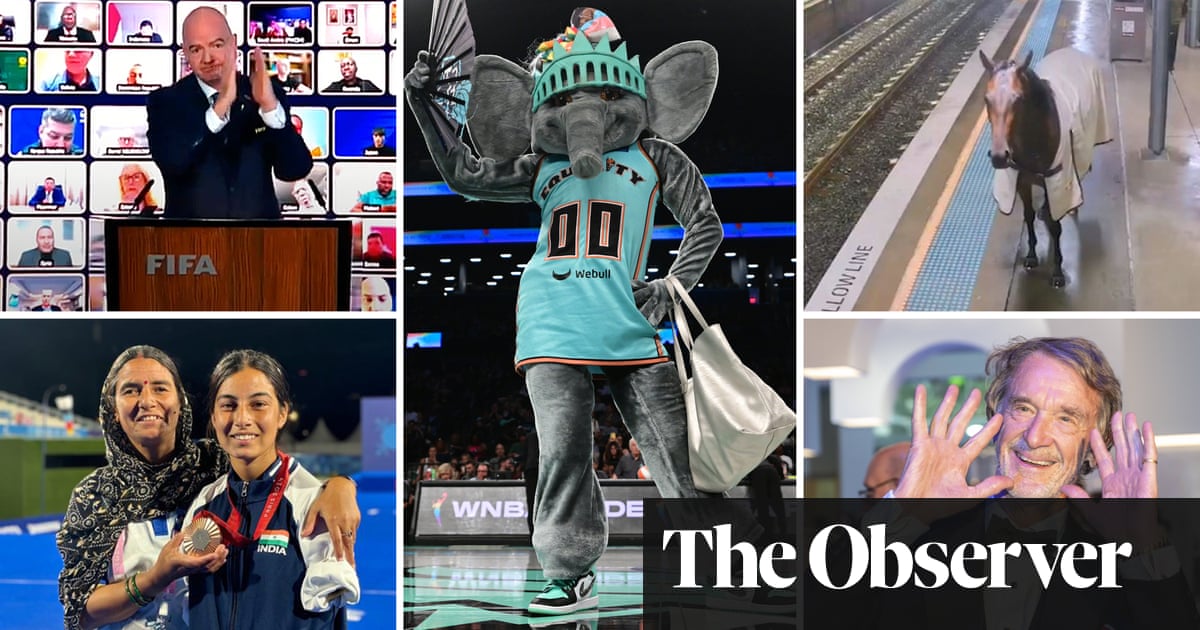‘Chicken jockey!” If you know what this phrase means, you’re either a preteen boy or have accompanied one to a recent cinema screening of A Minecraft Movie.
Warner Bros’ latest money-spinner is a movie adaptation of the Swedish game Minecraft, a prerequisite in the social lives of children between the age of eight and 12. The game enables children to explore and reconfigure a creative digital environment, accumulating resources in a world built from blocks. The movie enables children to explore and reconfigure the codes of basic decency in a cinema environment, testing the limits of any hapless usher left to supervise.
A Minecraft Movie means mischief. In recent days, a viral trend has encouraged audiences to wait for the onscreen moment when a zombie jumps piggyback on to a chicken – yes, actually – then to erupt into chaos, hurling popcorn around the theatre. The cue for action is marked by a character played by Jack Black, who spots the zombie-chicken combo and yells “chicken jockey!”. In a video of one such incident, a tween carrying a real-life chicken is paraded on the shoulders of a friend through cinema seats. It was the chicken jockey to end all chicken jockeys.
Clearly, the phenomenon is a nightmare for cinema staff, given the debris of snack foods crunched into carpets. Equally clearly, no adult arrives at A Minecraft Movie with an expectation of rapt silence. The exuberance of children recognising a key moment from their own gameplay should hardly inspire the disapproval some of us reserve for the oaf who disrupts an art house cinema. (I speak as someone with an acute sensitivity to noise and a long-honed repertoire of judgy looks.) A Krzysztof Kieślowski retrospective requires silence; the latest Jack Black vehicle does not.
If your tween is participating in the “chicken jockey” phenomenon, it’s less likely to be an act of rebellion, heralding a lifetime of social delinquency, so much as a requisite act of conformity. During A Minecraft Movie’s first weekend, very little disruption was reported in Britain. Now all the kids are doing it, inflamed by widely circulated news that a cinema in New Jersey had kicked back by banning unaccompanied minors. Cue British cinemas following suit; cue large parties of tweens proudly filming themselves flouting the rules; cue adult outrage. Childhood trends come and go, but the features of the mass hysteria around them stay largely the same.
The “chicken jockey” phenomenon is largely harmless – unless you’re the minimum-wage cinema staff who have to clear up. Warner Bros, desperate to create in-person experiences that require streaming audiences to return to cinema, has encouraged the trend, with director Jared Hess telling the world: “I’m just laughing my brains out every time someone sends me a new video.” It’s a messier version of the push to get women to head to cinemas wearing pink for Barbie or green for Wicked.
Yet the dispute lands just as audiences on both sides of the Atlantic are caught up in a feverish debate about post-Covid etiquette at cinemas, theatres and live music events. Producers and investors face the same dilemma. In a sector desperate for bums on seats, how far can they encourage traditional audiences to remember their visit as a participatory event? How far do the construction of “in-person” phenomena alienate existing audiences and disrupt the art itself?
The crisis sparked by our shifting norms during shared experiences has been most pronounced in theatre. Last year, two sisters were convicted of assault after punching a couple who asked them to keep quiet during a Glasgow performance of Jersey Boys: the court heard that the defendants, a nurse and a care-worker, had earlier in the altercation defended their right to make a noise as part of “enjoying themselves”.
It was only one of a series of incidents that have made headlines in the entertainment press. In April 2023, Alison Hammond and Vanessa Feltz were forced to apologise after advocating for the right to sing along in the audience when attending a musical. “Isn’t that what everybody does very, very loudly while eating an ice-cream?” asked Feltz on ITV’s This Morning. Nope, replied furious musical theatre professionals on social media.
As someone who spends up to four evenings a week at the theatre – a perk of my side-gig as a theatre critic – I’m a martinet about people making noise in the stalls. Live theatre depends on a shared experience and a shared commitment to concentration. The strongest case for keeping quiet in a theatre is that it’s profoundly selfish to distract the performers. While our screen age might have numbed some audiences into consuming all storytelling as if it’s projected from an LED monitor, actors and classical musicians are profoundly affected by distractions. As one singer tells me: “We hear every sweet wrapper; we see each light from a mobile phone.”
after newsletter promotion
Rock and rap performers are used to a bit more audience participation, but even they are struggling with the behaviour of fans who will do anything for a viral video: in 2023 Pink was visibly disturbed when a fan threw cremated ashes on to her stage; the same year, Cardi B responded by throwing her mic after a fan splashed her with liquid from a cup. In theatre, as in music, it is suggested that audiences forgot how to behave after the long Covid hiatus. I also blame the alcohol offers that venue owners, desperate for revenue streams after the pandemic, now push in “premium” packages.
In response, directors have finally accepted the need to remind theatregoers of basic behaviour, often with a pre-curtain speech by an actor. For years, the idea was sneered at by theatre’s progressives as “elitist” or “gatekeeping”, but it works. (I’ve never seen so many people turn off phones as when sharply instructed to do so by snobbish Emily, in character, in The Devil Wears Prada.) In Thomas Ostermeier’s recent version of The Seagull, we had a parody of such pre-curtain announcements, with one character encouraging the audience to “be present”, before reading out a list of rapid-fire prohibitions on everything from snogging to laughing. It still worked.
But although disruption has less impact on film than in theatre, film-makers have long understood that our experience in any cinema is shaped by those with whom we share it. A Minecraft Movie reminded me of a very different film: Maggie Gyllenhaal’s sensitive adaptation of the Elena Ferrante novel The Lost Daughter. Olivia Colman stars as a solo female holidaymaker, fighting for respect from a raucous mafia family in the same resort. In a scene that any lone woman who stands up for herself will recognise, their adolescent sons wilfully disrupt her experience of watching a movie by throwing popcorn. The question of who controls the soundscape at any collective experience is a question about who has power; who feels untouchable. Maybe it is time for the grownups to lay down the law.

.png) 22 hours ago
12
22 hours ago
12













































